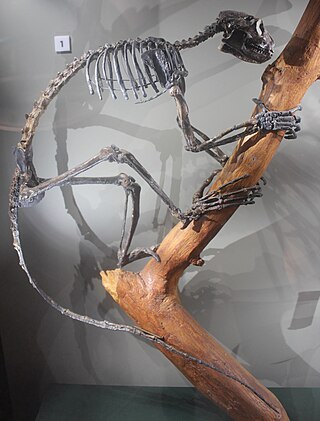
Plesiadapis is one of the oldest known primate-like mammal genera which existed about 58–55 million years ago in North America and Europe. Plesiadapis means "near-Adapis", which is a reference to the adapiform primate of the Eocene period, Adapis. Plesiadapis tricuspidens, the type specimen, is named after the three cusps present on its upper incisors.

Adapiformes is a group of early primates. Adapiforms radiated throughout much of the northern continental mass, reaching as far south as northern Africa and tropical Asia. They existed from the Eocene to the Miocene epoch. Some adapiforms resembled living lemurs.
Pronycticebus was a genus of adapiformes primates that lived during the middle to middle late Eocene. It is represented by two species, Pronycticebus gaudryi and Pronycticebus neglectus, of which an almost complete specimen was found in Germany, and the Quercy Phosphorites Formation of France.

Smilodectes is a genus of adapiform primate that lived in North America during the middle Eocene. It possesses a post-orbital bar and grasping thumbs and toes. Smilodectes has a small cranium size and the foramen magnum was located at the back of the skull, on the occipital bone.
Hesperolemur is a genus of adapiform primate that lived in the middle Eocene of southern California. It is an immigrant taxa which appears to be most closely related to the earlier European forms of Cantius. It was approximately 4.5 kilograms (9.9 lb) in weight and was the last surviving notharctine species, probably because of its position in the refugia that existed in southern California during the climate deterioration at the end of the middle Eocene. There are no later taxa that appear to have derived from Hesperolemur.

Europolemur is a genus of adapiform primates that lived in Europe during the middle Eocene.

Anaptomorphinae is a pre-historic group of primates known from Eocene fossils in North America and Europe and later periods of Paleocene Asia, and are a sub-family of omomyids. The anaptomorphines is a paraphyletic group consisting of the two tribes Trogolemurini and Anaptomorphini. Anaptomorphine radiation in Wyoming, one of the most detailed records of changes within populations and between species in the fossil record, has provided remarkable evidence of transitional fossils.
Djebelemuridae is an extinct family of early strepsirrhine primates from Africa. It consists of five genera. The organisms in this family were exceptionally small, and were insectivores. This family dates to the early to late Eocene. Although they gave rise to the crown strepsirrhines, which includes today's lemurs and lorisoids, they lacked the toothcomb that identifies that group.
Hoanghoniinae is a subfamily of adapiform primate that lived in Asia during the middle to late Eocene.
Lushius is a genus of adapiform primate that lived in China during the late Eocene, and is classified under the subfamily Hoanghoniinae.
Sivaladapis is a genus of adapiform primate that lived in Asia during the middle Miocene.
Kyitchaungia is a genus of adapiform primate that lived in Asia during the Eocene.
Paukkaungia is a genus of adapiform primate that lived in Asia during the Eocene.
Notnamaia is a genus of primates that lived in Africa during the early middle Eocene. It contains one species, N. bogenfelsi. Its describers considered it to be an early simian, but other researchers have generally placed it within Strepsirrhini, possibly aligned with the djebelemurids or caenopithecines.
Muangthanhinius is a genus of adapiform primate that lived in Asia during the late Eocene.
Sulaimanius is a genus of adapiform primate that lived in Asia during the late early Eocene. The genus was originally named Sulaimania, but was renamed in 2012 by the original authors to use the masculine form, Sulaimanius, to avoid a conflict with a genus of spider.
Asiadapinae is a subfamily within the extinct primate family Notharctidae found in Asia during the early Eocene. They were very small and were some of the earliest adapiforms, similar to cercamoniines but also sharing features with sivaladapids.
Marcgodinotius is a genus of adapiform primate that lived in Asia during the early Eocene. It is a monotypic genus, the only species being Marcgodinotius indicus. Another adapiform primate Suratius robustus was found in the same horizon. Anthrasimias may be a junior synonym of Marcgodinotius and Anthrasimias gujaratensis a junior synonym of Marcgodinotius indicus.
Magnadapis is a genus of adapiform primate that lived in Europe during the late Eocene.
Chipetaia is an extinct genus of primate in the family Omomyidae, containing the sole species Chipetaia lamporea, known from the middle Eocene of North America. Described in 1996 by D. Tab Rasmussen, the species is known from fossil teeth, femur fragments and hind foot bones Estimates of life weight based on the size of teeth and leg bones range from 500 to 700 g to as high as 1,000 g (2.2 lb). The genus name honors the Native American Ute diplomat Chipeta, while the specific name is Greek for "of the Shining Mountains," the Ute name for the Rocky Mountains.






